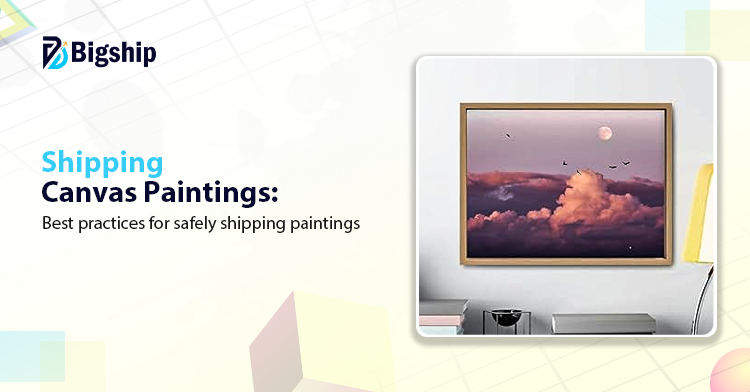Have you ever thought about how to pack oil paintings or any other artwork safely for shipping? If you’re an artist, collector, or selling a piece, it doesn’t matter. The key to keeping your artwork safe is proper packaging. A single mistake, like using the wrong materials, can lead to scratches, smudges, or even major damage. That’s why knowing how to mail a painting the right way is so important.
From choosing protective layers to picking a sturdy box, every step plays a role in keeping your artwork secure. In this guide, we’ll go over the best practices for shipping artwork and the common mistakes to avoid.
What Matters Most When You Ship Artwork?
Before packing and shipping, there are three key things you should focus on. These will help you avoid damage, impress buyers, and save money.
Painting is Safe: Nothing feels worse than hearing your buyer say their artwork arrived damaged. No matter how beautiful the piece is, a damaged shipment can ruin the experience. The best way to prevent this is by using the right packing materials and methods. In this blog, you will learn how to ship a canvas painting securely so it reaches its destination in perfect condition.
Packaging should be Professional: Artwork isn’t just a product, it’s something special. Buyers expect care and attention when they receive it. A package that looks neat and well-packed gives a good impression. It tells your buyer that you value both the artwork and their purchase. When you ship artwork, make sure the packaging reflects its worth.
Shipping costs should be under control: You will never want your shipping cost to eat up all the profit. While safety and presentation matter, they should also fit within your budget. Your goal should be to find a way to ship your artwork efficiently without overspending.
Common Problems When You Mail a Painting
When shipping artwork or painting, you need to be aware of all risks and challenges that might come your way. A small mistake can lead to damage of the fragile artwork, thus upsetting the customer. To avoid this, it’s important to know what can go wrong. Here are some common types of damage and why they happen:
Cuts and Tears: A sudden drop from other packages can cause sharp edges to cut through the canvas.
Scratches: Not wrapping the painting properly can lead to damage on the surface or frame.
Dents and Bends: Rough handling or stacking heavy items on top can bend the frame or canvas.
Water Damage: Rain, leaks, or moisture from other shipments can ruin the artwork if the packaging isn’t waterproof.
Chemical Reactions: Using the wrong materials (like acidic paper) can cause discoloration or fading of the painting over time.
Pest Damage: Rare, but when shipping a painting, rodents or insects can get into weak packaging and damage it.
Essential Tools and Supplies for Art Shipping
When it comes to shipping your artwork, having the right tools and materials makes all the difference. A well-prepared toolkit ensures that your artwork reaches its destination safely. So, here’s a detailed list of these key tools and supplies.
Tape Gun: A 2-inch tape gun with adjustable resistance makes sealing boxes quicker and more secure.
Box Cutter or Knife: A sharp, sturdy cutter is crucial for clean cuts when resizing or opening boxes.
Picture Boxes: You should keep different sizes available, especially telescoping boxes that adjust for larger paintings.
Bubble Wrap: Large bubbles provide the best cushioning to prevent damage. So, always use perforated rolls for easy handling.
Plastic Wrap (Pallet Wrap): This wrap acts as a protective skin over artwork to prevent scratches.
Cardboard Pads: Large sheets add extra padding between the painting and the outer box.
Packing Tape: Invest in high-quality, thick (3.5 mil) tape to secure your packaging properly.
“Fragile” Stickers: While they might not always guarantee careful handling, these stickers signal to your clients that you prioritize safety.
How to Pack Artwork for Shipping?
Shipping artwork can feel stressful, especially when dealing with delicate pieces like oil paintings or canvas prints. An artist, a gallery owner, or just sending a special piece to a loved one, it doesn’t matter who you are. What matters is proper packaging that ensures your artwork arrives safely.
So here’s the step-by-step guide on how to pack oil paintings and the best way to ship a canvas painting without damage.
Gather the Right Packing Materials: Before you start, make sure you have the essential tools and supplies already mentioned above. Some of these are glassine paper or acid-free tissue, bubble wrap, cardboard sheets, packing tape, and sturdy cardboard boxes.
Protect the Surface of the Artwork: For oil paintings, never wrap them directly in plastic, as it can trap moisture. Instead, use glassine paper or acid-free tissue to cover the front. This prevents smudging, dust accumulation, and scratches.
Add Cushioning with Bubble Wrap: Wrap the artwork in two layers of bubble wrap and secure it with tape. Make sure the bubbles face outward to avoid any imprints on the artwork. In case you are shipping a framed painting with glass, add an extra layer of cardboard or foam board between the glass and the painting for extra security.
Box It Up Securely: Choose a box that’s slightly larger than the artwork, so that there is space for additional padding. Place cardboard sheets around the artwork to act as a shock absorber. If shipping an unframed canvas, consider using a flat box or a tube (for rolled paintings).
For framed artwork, double-boxing is the best way to ship a canvas painting. Place the painting in one box, then put that box inside a larger one with extra padding in between.
Seal and label the package: Use heavy-duty packing tape to seal the box securely. Clearly label the package as “Fragile – Handle with Care” to alert the shipping carrier. If possible, also add “This Side Up” to prevent mishandling.
Choose the Right Shipping Service: Select a reliable courier with experience in handling artwork. If it’s a valuable piece, opt for insurance and tracking to ensure safe delivery. For international shipping, check for customs regulations on artwork to avoid delays.
Mistakes to Avoid When Shipping a Painting
Now that we’ve covered how to pack and ship a painting safely, let’s talk about some common mistakes that can ruin your artwork during transit.
Don’t Let Bubble Wrap Touch the Painting Directly: Bubble wrap is great for protecting artwork, but it should never touch the surface directly. If you wrap a painting in bubble wrap without a protective layer, the bubbles can stick to the varnish, thus leaving marks that ruin the finish. So to avoid this, always place a layer of paper or glassine over the artwork before using bubble wrap.
Avoid Old or Damaged Boxes: Reusing boxes might seem like a good idea, but weak or worn-out boxes can’t protect your painting properly. If you’re shipping to a customer, an old box also makes a bad impression. Always use a sturdy, new box to ensure safe delivery and maintain a professional image.
Say No to Packing Peanuts: Packing peanuts do not protect paintings properly. They shift inside the box and leave some areas unprotected which further increases the risk of damage. Instead, use bubble wrap or foam boards to fill gaps and keep the artwork secure.
Shipping Artwork Using Bigship’s Services
Shipping artwork, whether locally or internationally, can be made easy and smooth through Bigship. You can send your artwork domestically using Bigship’s reliable courier services to 29,000+ pin codes. You just need to sign up and book your order from the official website of Bigship.
For international shipping, Bigship provides affordable rates and takes care of customs clearance, so your artwork reaches its destination without delays. If you’re still wondering about the best way to ship a canvas painting, Bigship ensures real-time tracking so your artwork arrives safely, no matter where you send it.
Conclusion
Packing your artwork the right way ensures it reaches safely, no matter the distance. From using protective layers to choosing the right box, every step matters. The best way to ship a canvas painting is to prevent movement, use sturdy packaging, and avoid materials that could damage the surface.
If you’re thinking about the best way to ship a canvas painting, Bigship is the answer. Whether you’re shipping locally or internationally, Bigship offers reliable services to ensure your painting arrives in perfect condition. With more than 19+ reliable courier partners and cost-effective options, you can focus on your art while we handle the shipping.
So sign up with Bigship today and start sending your artwork to where it belongs!
FAQs
How to pack oil paintings for shipping?
To pack oil paintings safely, cover them with glassine paper, and use foam padding. Place the painting in a strong box and seal it properly to avoid damage.
What is the best box for mailing a painting?
A strong, double-walled cardboard box slightly larger than the painting is ideal. If shipping a framed painting with glass, use a wooden crate for extra protection.
Does Bigship offer services to ship a painting canvas?
Yes, Bigship provides affordable and reliable solutions for shipping painting both domestically and internationally, thus, ensuring your artwork reaches you safely.




